Can DeFAI, which deeply integrates DeFi and AI, give birth to a new wave of AI Agents?

Reprinted from panewslab
01/16/2025·19days agoAuthor: YBB Capital Researcher Ac-Core
1. What story does DeFAI tell?
1.1 What is DeFAI
To put it concisely and clearly, DeFAI is AI+DeFi. Regarding AI, the market has completed rounds of hype, from AI computing power to AI Meme, from different technical architectures to different infrastructures. Although the overall market value of AI Agents has generally declined recently, the concept of DeFAI is becoming a new breakthrough trend. The current DeFAI can be roughly divided into three categories: AI abstraction, autonomous DeFi agents, and market analysis and prediction. The specific divisions in the major categories are shown in the figure below.
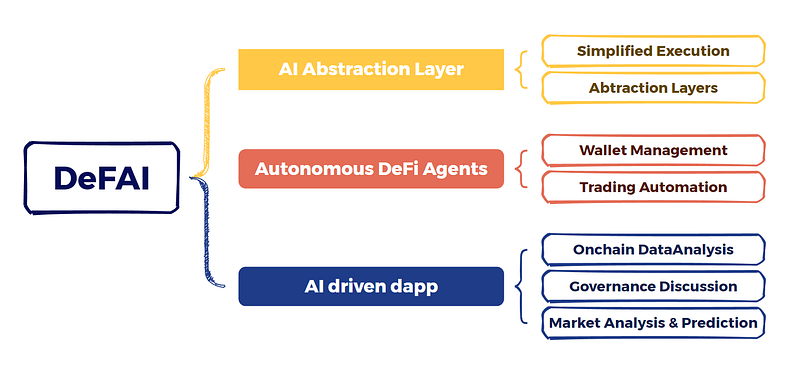
Source: self-made by the author
1.2 How DeFAI works
In the DeFi system, the core behind AI Agent is LLM (Large Language Model), and its operation involves multi-level processes and technologies, covering all aspects from data collection to decision execution. According to the research of @3sigma in the IOSG article, most models follow six specific workflows: data collection, model inference, decision-making, hosting and operation, interoperability, and wallet. The following is a summary:
1. Data collection: The primary task of an AI Agent is to gain a comprehensive understanding of its operating environment. This includes obtaining real-time data from multiple sources:
-
On-chain data: Obtain real-time blockchain data, such as transaction records, smart contract status, and network activities through indexers, oracles, and other means. This helps the Agent stay in sync with market dynamics;
-
Off-chain data: Obtain price information, market news and macroeconomic indicators from external data providers (such as CoinMarketCap, Coingecko) to ensure the Agent's understanding of external market conditions. These data are usually provided to the Agent through the API interface;
-
Decentralized data sources: Some agents may obtain price oracle data through decentralized data feed protocols to ensure the decentralization and credibility of the data.
2. Model reasoning: After data collection is completed, the AI Agent enters the reasoning and calculation stage. Here, Agent relies on multiple AI models for complex reasoning and prediction:
-
Supervised and unsupervised learning: By training on labeled or unlabeled data, AI models can analyze the behavior of markets and governance forums. For example, they can predict future market trends by analyzing historical transaction data, or speculate on the outcome of a certain voting proposal by analyzing governance forum data;
-
Reinforcement learning: Through trial and error and feedback mechanisms, AI models can autonomously optimize strategies. For example, in token trading, AI Agent can determine the best time to buy or sell by simulating multiple trading strategies. This learning method enables Agent to continuously improve under changing market conditions;
-
Natural Language Processing (NLP): By understanding and processing user natural language input, Agent can extract key information from governance proposals or market discussions to help users make better decisions. This is especially important when scanning decentralized governance forums or processing user instructions.
3. Decision making: Based on the collected data and the results of reasoning, the AI Agent enters the decision-making stage. At this stage, the Agent not only needs to analyze the current market conditions, but also makes trade-offs between multiple variables:
-
Optimization engine: Agent uses the optimization engine to find the best execution plan under various conditions. For example, when conducting liquidity provision or arbitrage strategies, Agent must consider factors such as slippage, transaction fees, network delays, fund size, etc., in order to find the optimal execution path;
-
Multi-agent system collaboration: In order to cope with complex market conditions, a single Agent sometimes cannot fully optimize all decisions. In this case, multiple AI Agents can be deployed, each focusing on different task areas, to improve the decision-making efficiency of the overall system through collaboration. For example, one Agent focuses on market analysis and another Agent focuses on executing trading strategies.
4. Hosting and operation: Since AI Agents need to process a large amount of calculations, their models usually need to be hosted on off-chain servers or distributed computing networks:
-
Centralized hosting: Some AI Agents may rely on centralized cloud computing services such as AWS to host their computing and storage needs. This approach helps ensure the efficient operation of the model, but it also brings potential risks of centralization;
-
Decentralized hosting: In order to reduce the risk of centralization, some agents use decentralized distributed computing networks (such as Akash) and distributed storage solutions (such as Arweave) to host models and data. Such solutions ensure decentralized operation of the model while providing durability of data storage;
-
On-chain interaction: Although the model itself is hosted off-chain, the AI Agent needs to interact with on-chain protocols in order to perform smart contract functions (such as transaction execution, liquidity management) and manage assets. This requires secure key management and transaction signing mechanisms such as MPC (multi-party computation) wallets or smart contract wallets.
5. Interoperability: The key role of AI Agent in the DeFi ecosystem is to interact seamlessly with multiple different DeFi protocols and platforms:
-
API integration: Agent exchanges data and interacts with various decentralized exchanges, liquidity pools and lending protocols through API bridges. This allows the Agent to access key information such as market prices, counterparties, and lending rates in real time, and make trading decisions based on this;
-
Decentralized messaging: To ensure the synchronization of the Agent with the on-chain protocol, the Agent can receive updates through a decentralized messaging protocol such as IPFS or Webhook. This allows the AI Agent to process external events in real time, such as the voting results of governance proposals and changes in liquidity pools, to adjust strategies.
6. Wallet management: AI Agent must be able to perform actual operations on the blockchain, and this all relies on its wallet and key management mechanism:
-
MPC Wallet: Multi-party computation wallet splits private keys among multiple participants, allowing agents to securely conduct transactions without single-point key risk. For example, Coinbase Replit’s wallet demonstrates how to use MPC to achieve secure key management, which allows users to delegate some autonomous operations to AI Agents while maintaining certain control;
-
TEE (Trusted Execution Environment): Another common way to manage keys is to use TEE technology to store private keys in a protected hardware enclave. This approach enables AI Agents to conduct transactions and make decisions in a completely autonomous environment without relying on third-party intervention. However, TEE currently faces problems of hardware centralization and performance overhead, but once these difficulties are solved, fully autonomous AI systems will become possible.
1.3 What is the origin of the sect? From intent to DeFAI
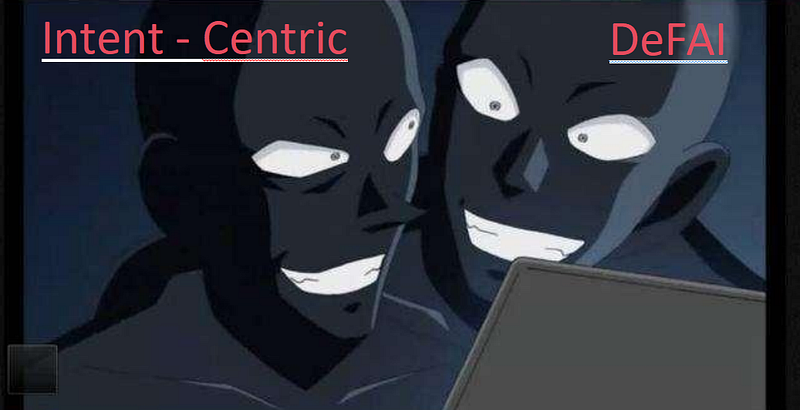
Source: self-made by the author
If DeFAI’s vision is to enable users to manage their portfolios autonomously through AI agents and various AI platforms, allowing everyone to easily participate in crypto market transactions, then does this vision naturally remind us of the concept of “intention”?
Let’s look back at the concept of “intention” first proposed by Paradigm. In our normal transactions, we need to specify a clear execution path, such as exchanging Token A for Token B in Uniswap, but in an intent-driven scenario, the execution path is matched and finally determined by the solver and AI. In other words: Transaction = I specify the execution method of TX; Intent = I only want the TX result but do not pay attention to the execution process. From the perspective of the rearview mirror, DeFAI's narrative is not only close to the final concept of AI Agent, but also perfectly fits the vision of realizing the intention. Overall, DeFAI is more like a new path to add intention.
The ultimate version to achieve large-scale application of blockchain in the future will be: AI Agent + Solver + Intent - Centric + DeFAI = Future?
2. DeFAI related projects
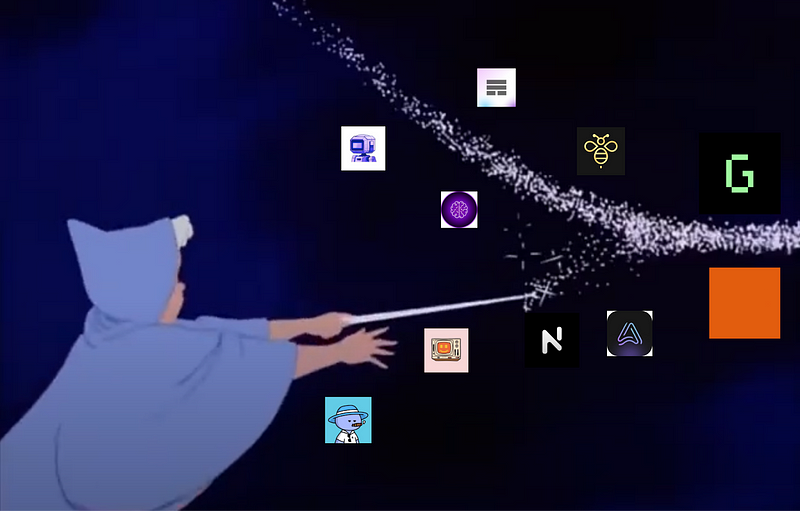
Source: self-made by the author
2.1 Griffin
@griffaindotcom $GRIFFAIN: It is an innovative platform that combines AI Agent and blockchain to help users issue AI Agents. The focus is to create a powerful and scalable decentralized finance (DeFi) solution to support seamless generation. Token swaps, liquidity provision and ecosystem growth. Easily manage wallets, transactions, and NFTs, and automate tasks such as Memecoin issuance and airdrops.
2.2 Hey Anon
@HeyAnonai $ANON: is an AI-driven DeFi protocol that simplifies interactions, aggregates real-time project data and performs complex operations through natural language processing, and is a user-friendly DeFi abstraction layer. DWF Labs announced its support for the DeFAI project Hey Anon through its AI Agent Fund and launched Moonshot on January 14.
2.3 Orbit
@orbitcryptoai $GRIFT: Simplifies the complex DeFi interface and operations, lowering the participation threshold for ordinary people,
It currently supports more than 100 blockchains and more than 200 protocols (EVM and Solana), and the token GRIFT is used to inject vitality into the platform.
2.4Neur
@neur_sh $NEUR: It is an open source full-stack application that brings together LLM models and blockchain technology functions. It is specially designed for the Solana ecosystem and uses the Solana Agent Kit to achieve seamless protocol interaction.
2.5 Mode network
@modenetwork $MODE: It is positioned as the central platform for Ethereum Layer 2’s AI
2.6 The Hive
@askthehive_ai $BUZZ: Built on Solana, it integrates multiple models including OpenAI, Anthropic, XAI, Gemini, etc. to implement complex DeFi operations such as trading, staking, and lending.
2.7 Bankr
@bankrbot $BNKR: is an artificial intelligence-driven cryptocurrency companion that allows users to easily buy, sell, exchange, place limit orders and manage wallets by simply sending a message, with plans to add token swaps and on-chain tracking capabilities in the near future , the vision is to enable everyone to use DeFi and realize automated transactions.
2.8 HotKeySwap
@HotKeySwap $HOTKEY: Provides a complete set of DeFi tools such as AI-driven DEX aggregator and analysis tools, cross-chain transactions, and supports cross-chain transactions and analysis.
2.9 Gekko AI
@Gekko_Agent $GEKKO: An AI agent created by Virtuals protocol, focusing on providing comprehensive automated trading solutions, an AI agent specially made for prediction markets. Automated trading strategies for GEKKO tokens include automatic rebalancing, yield harvesting and creation of new token index functions.
2.10 ASYM
@ASYM41b07 $ASYM: Provides an AI-driven DEX aggregator and analysis tools that can identify high ROI opportunities and settle the generated profits in $ASYM.
2.11 Wayfinder Foundation
@AIWayfinder $Wayfinder: An AI full-chain interactive tool launched by the card game chain game Parallel to help Agents navigate in the on-chain environment, perform transactions and interact with decentralized applications.
2.12 Slate
@slate_ceo $Slate: It is a general artificial intelligence agent and the connection infrastructure layer of agents. It focuses on the execution of automated trading strategies through natural language commands and translating them into on-chain operations, buying or selling under specific conditions, making On-chain operations are as easy as thinking.
2.13 Cod3x
@Cod3xOrg $Cod3x: The Solana AI hackathon project provides no-code development tools to build agents that can automate DeFi strategies. Its Agentic Interface is a tool that can perform complex operations using only intent expressions.
2.14 Almanak
@Almanak__ $Almanak: An AI Agent with self-learning capabilities that can perform tasks autonomously, using agent-based modeling to optimize DeFi and gaming projects. The mission is to use data science and transaction knowledge to maximize the profitability of the protocol, while ensure its economic security.
2.15HIERO
@HieroHQ $HTERM: A multi-chain smart tool for Solana and Base networks that allows users to use natural language to command agents to autonomously complete transactions, including buying and selling tokens, performing simple token analysis, etc.
3. What system does the endpoint of AI Agent belong to?
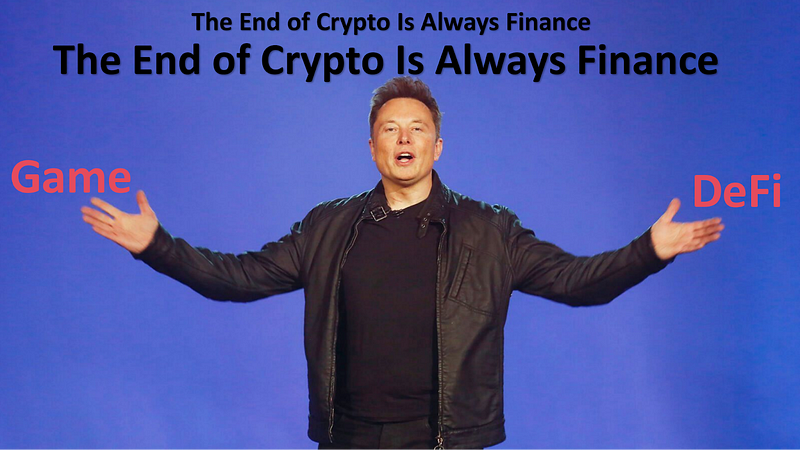
Source: self-made by the author
The weather is tight, and DeFAI projects are springing up like mushrooms after a rain. After Bitcoin fell sharply below $90,000 on January 13, DeFAI-related tokens bucked the trend and rose by 38.73% the next day according to CoinGecko data, with $GRIFT, $BUZZ and $ANON seeing the largest increases. But the financial direction of AI Agent is worthy of our consideration. The current nail-biting intersection points to Game on the left and DeFi on the right.
3.1 Game to the left:
M3 (Metaverse Makers_) (@m3org) is perhaps the most promising representative. The project is composed of artists and open source hacker communities suspected of being the organization behind ai16z. The core members of its team include JIN (@dankvr), Reneil (@reneil1337 ), Saori (@saori_xbt), Shaw (@shawmakesmagic), etc. But Game's biggest practical obstacle is that in the Web2 market, which is rich in manpower and resources, there has never been a truly popular AI game. In January 2024, the high-profile "Phantom Beast Palu" caused controversy about whether to use AI design because of its development efficiency that was far beyond ordinary people, but the CEO ultimately denied this statement. In addition, the game itself requires a long development cycle. Compared with DeFI, which is moving to the right, AI Game seems to require more market enthusiasm.
3.2 DeFi to the right:
The project market value ranks in order $GRIFFAIN, $ANON, $OLAS, $GRIFT, $SPEC, $BUZZ, $RSS3, $SNAI, and $GATSBY. The combined market value of GRIFFAIN and ANON accounts for 37.29% of the overall market value of DeFAI.
GRIFFAIN: Built in Solana, it currently ranks first in the DeFAI market value rankings with a market capitalization advantage of $457M and 103,000 followers on Twitter. Its core function is to complete pointing transactions, fast transactions and other functions by generating a wallet. Currently, 0.01 Sol can be spent to complete the NFT casting of The Agent Engine.
Hey Anon: Using a multi-training model, it currently supports different public chains such as Sonic Insider, Solana, EVM, opBNB, etc. The sudden sprint of $ANON is entirely driven by the aura of founder Daniele (@danielesesta), who is also the founder of Wonderland, Abracadabra and The founder of WAGMI, relying solely on traffic has injected a lot of vitality into $ANON, Hey As his next entrepreneurial project, Anon currently ranks second with a market value of $248M.
4. Summary
The emergence of DeFAI is not accidental. The core feature adaptation of blockchain is strong financial scenarios. Currently, both GameFAI and DeFAI have shown comparable market potential. In the Game direction to the left, there may be a continuation of the inherited metaverse in the future. With the help of AI, virtual property, characters, economy and other aspects can be managed. AI Agent's elemental gameplay of meme reproduction can be used to achieve independent evolution. Metaverse autonomy and prosperity.
As DeFi develops to the right, it will inevitably move from passionate emotional hype to an endpoint oriented by actual value. The value of AI Agent cannot rely on issuing memes to cater to market trends, but the continuation of the AI Agent story must be supported by DeFi-like income matryoshkas. The victorious king will not wear armor forever, and the final result of market competition is worthy of our eagerness. treat.

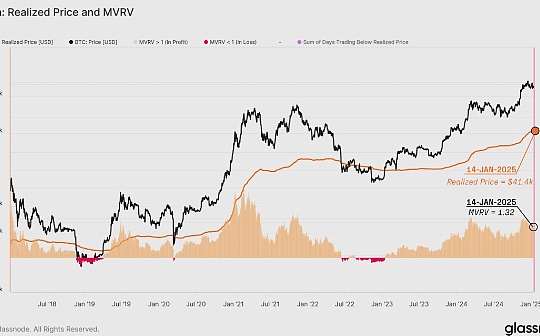
 jinse
jinse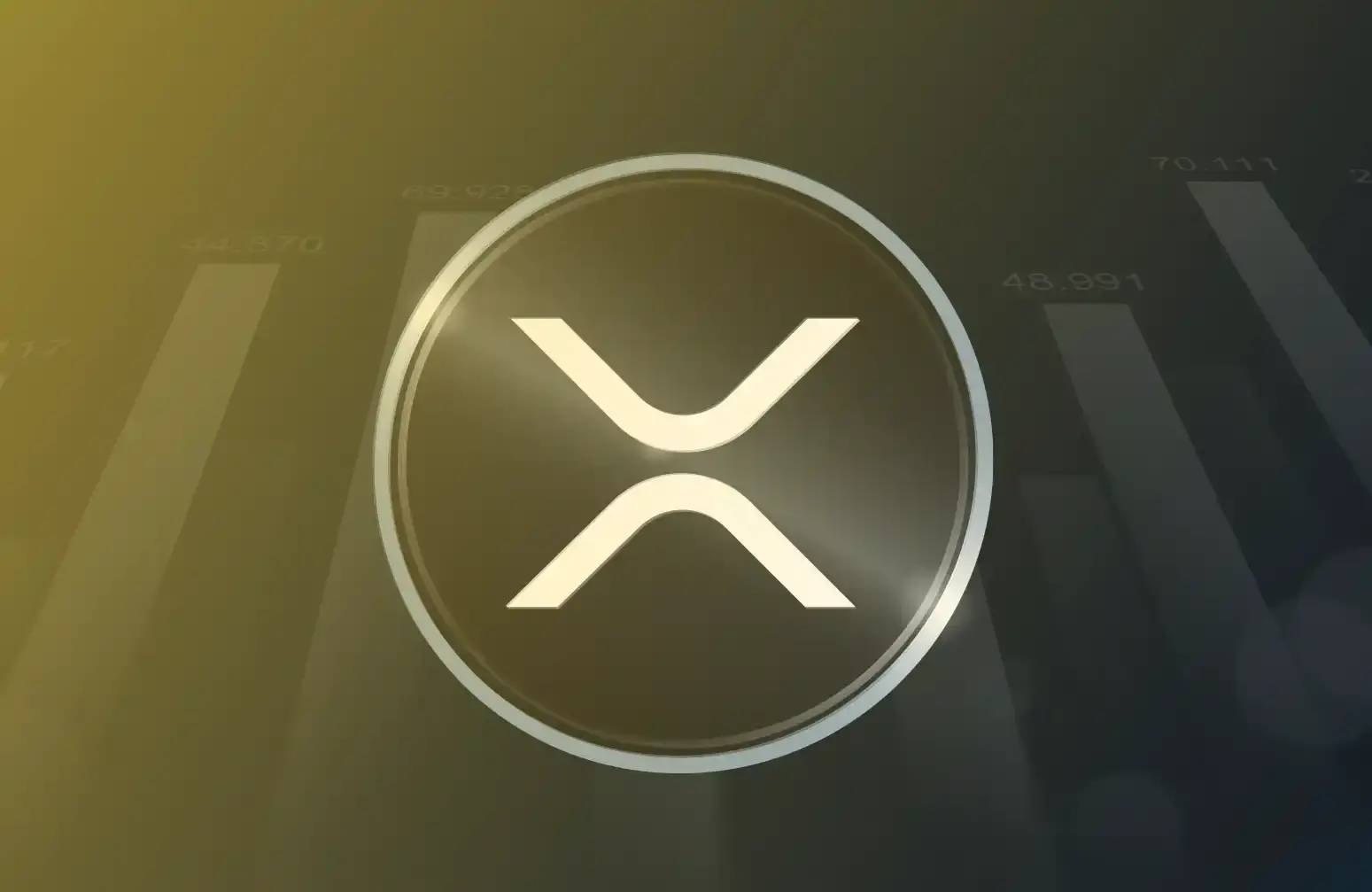
 chaincatcher
chaincatcher